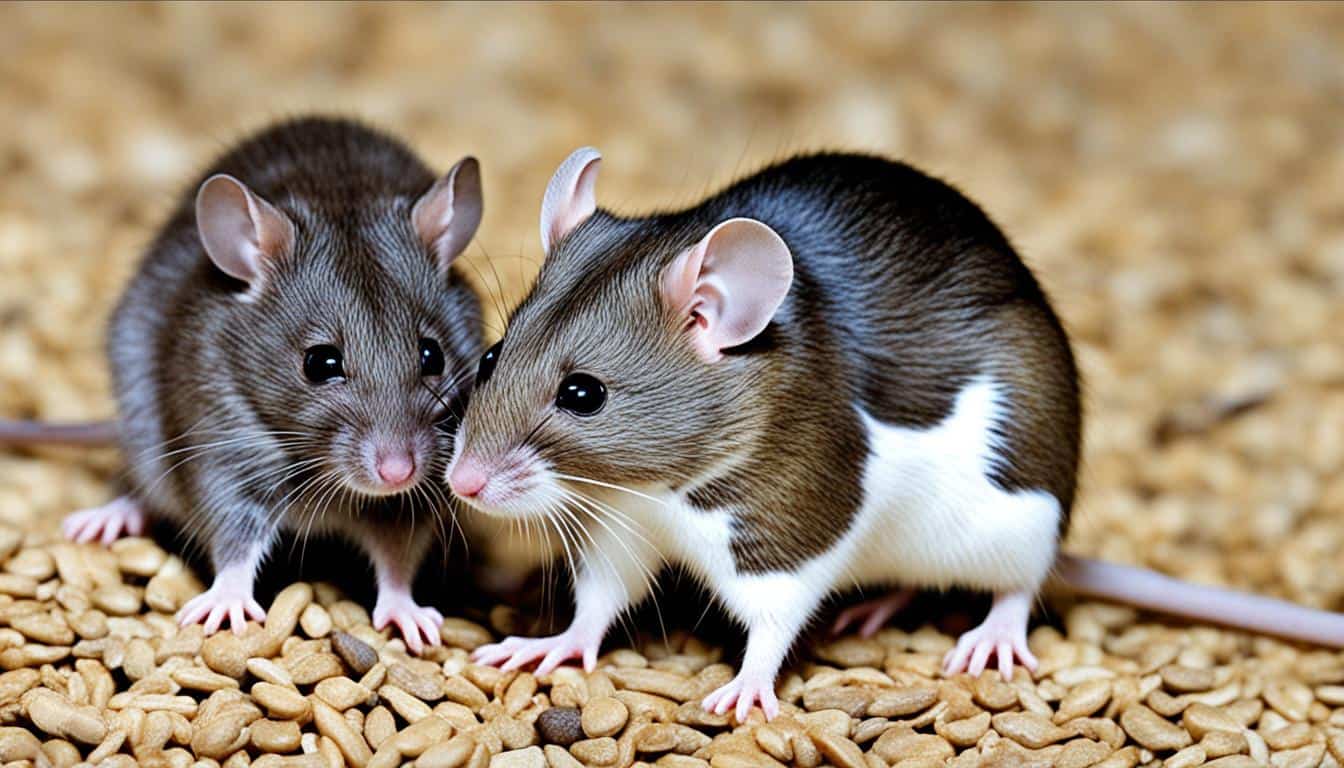Ever asked yourself, “Is that a rat or a mouse?” It’s tricky to tell the difference at first. But knowing how to spot the rat vs mouse differences is crucial. It helps you keep your home safe from infestations.
Size, look, and actions help tell a rat from a mouse. Mice are smaller, 12 to 20 cm long, and weigh 12 to 30 grams. They have pointy faces and long whiskers. Also, they are usually active at night, shy, like being around others, and are picky about where they live.
Rats, on the other hand, are bigger, reaching up to 40 cm and beyond. They have chunky faces and tails without fur. Like mice, they prefer the cover of night and a wide range of environments. To tell them apart, look closely at their sizes, face shapes, ear sizes, tails, and so on.
Knowing these features lets you figure out if it’s a rat or a mouse. This insight improves your rodent species identification. That, in turn, boosts your pest control plans.
Size Comparison: Rat vs Mouse
When we think about the differences between rats and mice, size stands out the most. These rodents have distinct sizes that help us tell them apart easily.
Body Length
Mice are small, measuring between 12 to 20 cm long. But rats are much bigger, reaching lengths of up to 40 cm. This size disparity is a clear sign of which rodent is which.
Tail Length
The length of their tails is another key difference. A mouse’s tail is about the same length as its body, while a rat’s is much longer. Rats’ tails are skin-covered and without fur, unlike the thin, furry tails of mice.
Weight
Mice and rats also differ in weight. A mouse is quite light, weighing between 12 to 30 grams. Rats are heavier, weighing from 12 ounces to 1.5 pounds when fully grown.
These distinctions in size play a vital role in telling a rat apart from a mouse. Knowing the distinct rodent characteristics rat vs mouse can help you identify them correctly.
Head and Snout Differences
It’s important to know how to spot differences in rodents, like rats and mice. Their heads and snouts look different. These features make each kind of rodent unique.
Shape of the Snout
Mice have a snout that’s shaped like a triangle, making their faces look sharp. Rats, on the other hand, have a less pointy snout. This gives them a more round-faced look. So, the shape of the snout is a big clue when telling rats and mice apart.
Proportion of Head
Mice have big ears compared to their heads. In contrast, rats have smaller ears that are very close to their heads. Spotting these differences in head size can help you figure out what kind of rodent you’re seeing.
Here’s a detailed comparison:
| Feature | Mice | Rats |
|---|---|---|
| Snout Shape | Triangular | Blunt |
| Ear Proportion | Larger, prominent | Smaller, flatter |
Color Variations
Seeing the differences in rodent fur can indicate if it’s a rat or a mouse. Mice usually have fur from white to brown to gray. Their fur is the same all over and feels softer.
On the flip side, rats have a wider range of fur colors like white, gray, brown, and black. Their fur may look dirty and rough, leaving grease marks. This different fur feel is a big sign to tell rats and mice apart by their fur color.
Looking at tail colors is also helpful. Mouse tails are much like their fur, blending in. But, a rat’s tail stands out as it’s lighter and might have a hint of pink. These clues help in figuring out which rodent is around.
Ear Size and Shape
The mouse ear characteristics and rat ear description are key in telling mice and rats apart. Mice have big, floppy ears that look too big for their heads. Rats, on the other hand, have smaller, more fitting ears that lie close to their heads. These distinct ear features help spot if you’re seeing a mouse or a rat. Looking closely at these can give clues about the type of rodent you’re dealing with.
| Feature | Mouse Ear Characteristics | Rat Ear Description |
|---|---|---|
| Size | Large, disproportionate to head | Smaller, proportionate to head |
| Shape | Floppy and circular | Flattened and rounded |
| Position | Stand out from the head | Lie flat against the head |
If you focus on these features, telling mice and rats apart becomes simpler.
Tail Characteristics
Examining a rodent’s tail can tell you a lot. You look at hairiness, scaliness, length, and texture to know if it’s a mouse or a rat. This understanding is key for anyone who wants to be good at telling them apart.
Hairy vs Hairless
One way to spot the difference is by looking at the tail’s hair. Mice have long, thin tails with soft hair on them. In comparison, rats have tails that are hairless and thicker. This makes it easy to know which is which.
Scaly vs Smooth
The texture helps too. Rat tails have a noticeable rough, scaly feel when you touch them. In contrast, mouse tails are smoother and uniform. These differences are important for accurate identification.
| Characteristic | Mouse Tail | Rat Tail |
|---|---|---|
| Hairiness | Hairy | Hairless |
| Texture | Smooth | Scaly |
| Thickness | Thin | Thicker |
Noticing the hairiness, texture, and tail details helps you know if it’s a mouse or rat. This is really useful for people dealing with pests or anyone studying animals scientifically.
Behavioral Traits
Knowing about rodents’ behaviors is key to identifying them. Rats and mice act differently, although they have some things in common.
Nocturnal Nature
Rats and mice love the night. This means we often hear or see them when it’s dark outside. Mice, with their incredible curiosity, explore their environment thoroughly at night. They aren’t scared of new things as much as rats are.
Level of Caution
Rats are very careful, unlike mice. They tend to stay away from new things, showing a reserved attitude. This caution is a big clue when figuring out if you have a rat or mouse at home or work. Even though both are good at swimming and climbing, rats hesitate more in new places.

Even though both like the night, their caution levels differ. Mice can move fast and fit into small places. Recognizing this helps us tell the two rodents apart accurately.
| Behavior | Mice | Rats |
|---|---|---|
| Nocturnal Nature | Active and curious | Cautiously active |
| Level of Caution | Less cautious, more explorative | More cautious, avoids new objects |
| Agility | Highly agile, fits through small openings | Agile but more measured in movements |
Habitat Preferences
It’s key to know what rodent habitat preferences are to control mice and rats well. They each like different places to live. This influences where they make their nests, changing how we deal with them.
Urban vs Rural Settings
Mice and rats live differently in cities and the countryside. In cities, mice find homes to live in and nest in cozy, hidden spots. They often live near us, behind appliances or inside walls. Their small size helps them get into tiny spaces.
On the other hand, rats like the outdoors spaces. They make burrows under buildings or find homes up high, like in trees. They look for places with food and water nearby, making cities a good home with lots of trash.
Nesting Locations
Where mice and rats build their nests shows more about where they prefer to live. Mice pick quiet, indoor spots like attics or basements. They make nests from things like paper, fabric, and insulation.
Rats, however, are more adaptable. Norway rats dig into the ground or stay close to buildings. Roof rats often choose to nest up high in trees or attics. Knowing where they nest helps us find the right way to control them.
| Rodent Species | Preferred Habitat | Common Nesting Locations |
|---|---|---|
| Mice | Urban and Rural | Inside homes, behind appliances, attics, basements |
| Norway Rats | Urban | Burrows in ground, around building foundations, sewers |
| Roof Rats | Urban and Rural | Trees, attics, upper parts of structures |
Breeding and Lifespan
Rats and mice differ not just in looks but in how often they have babies and how long they live. Both animals have many babies, but the numbers and frequency are not the same. Knowing this helps control their numbers.
Rats have up to six litters a year, with up to 12 babies each time. Mice, on the other hand, can have five to ten litters yearly, about six babies per litter. This rapid breeding leads to quick growth in the rodent population, which is why it’s important to control them early.
Average Lifespan
Rats and mice live for various lengths of time, which is helpful in managing how many there are. If conditions are perfect, they might live up to 30 months. Sadly, outside factors often cut this short. Understanding their lifespan can help in controlling them effectively.
Knowing about the rats and mice’s breeding and lifespan helps predict and handle their numbers well. This information is crucial to fighting these pests.
FAQ
How do you distinguish between a rat and a mouse?
To tell rats and mice apart, look at their size, shape, and how they act. Mice are smaller, about 12 to 20 cm long, with pointy noses and big ears. Rats are bigger, going up to 40 cm, with round noses and small ears. They both come out at night, but mice are more into exploring while rats are more careful.
What are the significant rat vs mouse differences in terms of size?
Mice are about 12 to 20 cm long and weigh 12 to 30 grams. Rats, on the other hand, can be from 12 oz to 1.5 lbs, sometimes almost as big as squirrels. This big size difference is often the easiest way to tell if you’re looking at a rat or a mouse.
How can you tell a rat from a mouse by their snout shape?
Rats have a more rounded nose and ears that are quite little for their body size. Mice have a pointy nose and large, round ears. Spotting these different snouts and ears helps tell rats and mice apart.
What are the color differences between rats and mice?
Mice come in colors like white, brown, and gray; their fur feels light and soft. Rats can also be white, gray, brown, and black but their fur seems dirty and greasy, sometimes leaving marks. A big giveaway is that rat tails are often a noticeable lighter shade than the rest of their body.
How do ear size and shape help in distinguishing rodent species?
Mice have big, round ears that look huge on their heads. Rats, however, have ears more in proportion to their head and they’re not as noticeable. Knowing their ear sizes and shapes can clue you in on who’s who.
What are the tail characteristics that differentiate rats and mice?
The tails of mice are long and slender, with hair all over. Rat tails, unlike mice, are thicker, scaly, and often without hair. Checking out their tails gives a clear sign of which type you’re seeing.
What behavioral traits are unique to rats and mice?
Mice are very curious and like to check out new places. Rats, on the other hand, are more wary and stay away from places they don’t know well. Mice are excellent at fitting into tiny spaces because they are smaller than rats.
How do habitat preferences differ between rats and mice?
Mice love living in quiet spots, such as behind big machines or piled up stuff. Rats prefer to dig burrows in the ground floors of buildings or live in trees. Mice might also pick attics and basements, while rats could choose sewers.
What are the breeding habits and lifespan differences between rats and mice?
Rats have up to six litters a year, each time having up to 12 babies. Mice, however, can have from five to ten litters a year, and each litter might have around six pups. Both can live up to 30 months, but many don’t reach that because of where they live.







